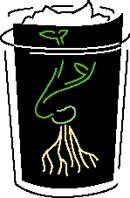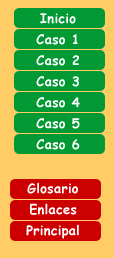Caso 3 - Background Information
Seeds come in different sizes, shapes, and colors. Some are edible
and some are not. Some seeds germinate readily while others need
specific conditions to be met before they will germinate.
When looking at a seed, realize and convey to the students that
within every seed lives a tiny plant or embryo. An idea to convey
is that a small child can hold in their hand 500 radishes, several
hundred thousand petunias, or an entire meadow if you consider
each seed to be a plant and relate it to the size of each seed.
Plants have the ability to move in the form of seeds. They can't
just get up and walk to a new location, but structures on the
seed may allow it to move to a new location. Some of the moving
forces might be wind, water, animals, and gravity. Have students
collect seeds of garden and wild plants. Look at them and speculate
how they might be moved from place to place.
Seed structure. The outer covering of a seed is called the seed
coat. Seed coasts help protect the embryo from injury and also
from drying out. Seed coats can be quite thin and soft as in beans
or very think and hard as in locust or coconut seeds. Endosperm,
which is a temporary food supply, is packed around the embryo
in the form of special leaves called cotyledons or seed leaves.
These generally are the first parts visible when the seed germinates.
Plants are classified based upon the number of seed leaves (cotyledons)
in the seed. Plants such as grasses and grass relatives can be
monocots, containing one cotyledon. Dicots are plants that have
two cotyledons. Seeds remain dormant or inactive until conditions
are right for germination. All seeds need water, oxygen, and proper
temperature in order to germinate. Some seeds require proper light
also. Some germinate better in full light while other require
darkness to germinate.
When a seed is exposed to the proper conditions, water and oxygen
are taken in through the seed coat. The embryo¹s cells start
to enlarge and the seed coat breaks open and root or radicle emerges
first followed by the shoot or plumule which contains the leaves
and stem.
Many factors contribute to poor germination. Overwatering results
in a lack of proper oxygen levels. Planting seeds to too deep
results in the seed using up all of its stored energy before reaching
the soil surface, and dry conditions result in the lack of sufficient
moisture to start and sustain the germination process.
Some seeds may be inhibited from germinating because of either
physical or physiological dormancy. Physical dormancy usually
takes the form of a seed coat that is so hard that water and oxygen
cannot get through until the coat breaks down. These seeds benefit
from being soaked or scratched lightly before planting. Morning
glories and locust seeds are examples. Physiological dormancy
results when the internal chemistry of the seed needs to be corrected
by exposing the seed to proper temperatures. Seeds such as apple
will not germinate unless exposed to cold temperatures for a period
of time. Both of these adaptations prevent the seed from germinating
until conditions are right for their survival.
Nonflowering plants like ferns reproduce by seed-like structures
called spores. These spores are generally found on the undersides
of leaves and look like tiny tufts of velvet. Spores are ripe
when they readily fall off the leaf. A collection of ferns in
the classroom will generally yield a nice display of spores, arrangement
of spores, and colors. You may want to try to germinate them but
it takes a very long time for germination to occur and for a plant
to develop.
 The seed viewer activity allows the student to observe the germination
process without the interference of a soil medium. The seeds used
in the activity will germinate and grow for a short time while
being nourished by food stored in the cotyledons. Eventually they
will need nutrients from a soil medium to continue to grow. You
may want to transplant a few germinated seeds in soil and note
differences between those in the seed viewer and those in the
soil. This activity can also sharpen observation skills. Students
can not how the seed changes physically during germination. You
might also incorporate different or no light levels, different
temperatures, or different moisture levels and see how or if it
affects germination.
The seed viewer activity allows the student to observe the germination
process without the interference of a soil medium. The seeds used
in the activity will germinate and grow for a short time while
being nourished by food stored in the cotyledons. Eventually they
will need nutrients from a soil medium to continue to grow. You
may want to transplant a few germinated seeds in soil and note
differences between those in the seed viewer and those in the
soil. This activity can also sharpen observation skills. Students
can not how the seed changes physically during germination. You
might also incorporate different or no light levels, different
temperatures, or different moisture levels and see how or if it
affects germination.
The seed within activity is best done with seed that has been
soaked in water overnight. Lima beans are good examples of dicot
seeds and corn can be used for monocot seeds. The beans will easily
open into two halves. The corn will have to be cut in half lengthwise
to view the inside. Students should draw what they see and offer
explanations of the differences.
|



